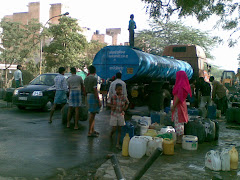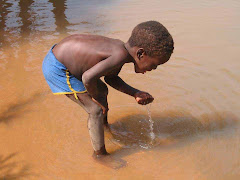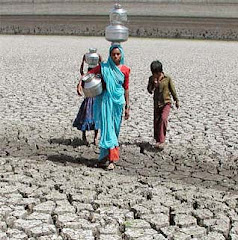After the discovery of water on moon, Indian scientists are looking at possibilities to tap the resource. For them, next on the agenda: transforming the lunar water that exists in vapour form into liquid state for utilizing it on Earth or using it for setting up human bases on the Moon.
A team of Indian scientists is reportedly studying ways and means to collect the lunar water after discovering the north and south poles of the Moon contained about one billion tonne of water or water-ice. Since the discovery of water in September 2009, scientists have announced that water is present on the Moon in vapour and ice form also.
Former Indian Space Research Organisation (ISRO) chairman G Madhavan Nair was quoted recently as saying, "As the water on Moon is mostly in its vapour and ice form, space scientists are studying scientific means of converting that into liquid water on the lunar surface itself".
Nair, a space scientist himself, was at the helm of ISRO's Chandrayaan-1 mission, India's first mission to the Moon.
Scientists believe discovery of water ice on the Moon is important as it can serve as a natural resource for astronauts on future lunar landing missions. The ice could also be melted into drinking water or be separated into its components of oxygen and hydrogen to provide breathing air and rocket fuel for launching interplanetary missions from the moon.
"Studies are being conducted to assess whether oxygen concentrators can be used for a similar process to liquidate the water vapour to have large quantities of liquid water in the challenging lunar environment", said Nair, adding that since exploitation of Moon and Mars for colonisation is the next step, plans are also being chalked out to reach there at an affordable cost.
News reports state that NASA has shown confidence that these vast sources of water on Moon could also be used to generate oxygen that could sustain human life in the lunar bases. Also, European Space Agency scientists are also reportedly studying the process of interaction between the hydrogen nuclei and oxygen present in the lunar dust grains to produce hydroxyls and water.
Nair said the next step could be to have ISRO's planned lander under Chandrayaan-2 taken to the Moon's polar region. "We could go further beneath the surface with appropriate instruments, and this time, it could be deeper than what Mini-Sar has managed. That will further seal all estimates we have made about water on the Moon. I believe getting to the spot and examining the area from deep under the surface could change all ways of thinking about the Moon", he added.
Monday, March 22, 2010
Monday, March 15, 2010
World's leading companies not forthcoming on water-related risk disclosures: Report
Most companies operating in water-intensive sectors including utilities and computer-chip makers are failing to provide investors with enough information on water-related risks, a report has warned.
Also, investors have almost no idea how their supply chains could be hit by water shortages in the future in several cases, the report -- 'Murky Waters: Corporate Reporting on Water Risk' -- prepared by sustainable investor group CERES and financial services firm UBS, states.
Even though most of these publicly-traded companies depend on water, they do not adequately disclose their financial risks to droughts and future regulations, even as water scarcity problems mount across the world.
The report, released last month, assessed the water-related disclosures of 100 of the world's largest publicly traded companies operating in the food, drink, electricity, mining, oil and gas, semiconductor, chemicals and construction industries.
It scored the companies based on five key categories of disclosure: water accounting, risk assessment, direct operations, supply chain and stakeholder engagement.
Puting the companies' water policies on a scale of up to 100, the report found that even the best-performing firms like beverage giant Diageo, Swiss mining company Xstrata and US electricity provider Pinnacle West, scored not more than 43 points. Eighty of the 100 companies scored fewer than 30 points.
Overall, several companies did not include any information on water risks and performance in their financial filings and provided no data on how water shortages could affect facilities operating in water-stressed regions.
Non-availability of water has emerged as a formidable business risk across the world. Poor water availability as well as an increase in its procurement cost are predicted with increasing frequency and climate change and poor management of water resources are expected to exacerbate the problem of scarcity.
CERES, which is a Boston-based coalition of investors with $8 trillion USD under management, used information collected by Bloomberg LP from corporate reports and financial filings of beverage, chemicals, electric power, food, homebuilding, mining, oil and gas and semiconductor companies. UBS analyzed the data for CERES. Regulatory, reputational and litigation risks related to water supply were also looked into.
The report states that not even one company from the 100 selected had provided detailed water data on its supply chains, despite the fact that many of them operate global supply chains with sizeable water footprints across several areas of the world that are at high risk from the increased incidence of droughts.
It cites some recent incidents where businesses have been affected by regional water shortages. For instance, the drought in California last year reportedly cost the state's agricultural industry $1 billion USD (£640 million) and led to the loss of an estimated 21,000 jobs. Similarly, the 2007-08 drought in Georgia increased costs for energy firm Southern Co by $33 million as it was forced to replace falling hydroelectric power output with more costly fossil fuel-based power.
Also, investors have almost no idea how their supply chains could be hit by water shortages in the future in several cases, the report -- 'Murky Waters: Corporate Reporting on Water Risk' -- prepared by sustainable investor group CERES and financial services firm UBS, states.
Even though most of these publicly-traded companies depend on water, they do not adequately disclose their financial risks to droughts and future regulations, even as water scarcity problems mount across the world.
The report, released last month, assessed the water-related disclosures of 100 of the world's largest publicly traded companies operating in the food, drink, electricity, mining, oil and gas, semiconductor, chemicals and construction industries.
It scored the companies based on five key categories of disclosure: water accounting, risk assessment, direct operations, supply chain and stakeholder engagement.
Puting the companies' water policies on a scale of up to 100, the report found that even the best-performing firms like beverage giant Diageo, Swiss mining company Xstrata and US electricity provider Pinnacle West, scored not more than 43 points. Eighty of the 100 companies scored fewer than 30 points.
Overall, several companies did not include any information on water risks and performance in their financial filings and provided no data on how water shortages could affect facilities operating in water-stressed regions.
Non-availability of water has emerged as a formidable business risk across the world. Poor water availability as well as an increase in its procurement cost are predicted with increasing frequency and climate change and poor management of water resources are expected to exacerbate the problem of scarcity.
CERES, which is a Boston-based coalition of investors with $8 trillion USD under management, used information collected by Bloomberg LP from corporate reports and financial filings of beverage, chemicals, electric power, food, homebuilding, mining, oil and gas and semiconductor companies. UBS analyzed the data for CERES. Regulatory, reputational and litigation risks related to water supply were also looked into.
The report states that not even one company from the 100 selected had provided detailed water data on its supply chains, despite the fact that many of them operate global supply chains with sizeable water footprints across several areas of the world that are at high risk from the increased incidence of droughts.
It cites some recent incidents where businesses have been affected by regional water shortages. For instance, the drought in California last year reportedly cost the state's agricultural industry $1 billion USD (£640 million) and led to the loss of an estimated 21,000 jobs. Similarly, the 2007-08 drought in Georgia increased costs for energy firm Southern Co by $33 million as it was forced to replace falling hydroelectric power output with more costly fossil fuel-based power.
Monday, March 1, 2010
First community-run water system in Andhra Pradesh to go live today
WaterHealth India, which has won a concession by the government of the south Indian state of Andhra Pradesh to run community water systems in five of the state's 23 districts on a (build, own, operate and transfer) BOOT basis, will make its first project site live by March 1.
The company was one of the five selected from 40 companies that had sought to provide safe and clean drinking water to a large majority of villagers across the state at affordable prices.
WaterHealth India, a wholly-owned subsidiary of US-based WaterHealth International Inc, provides purified water through its water purification centers, called WaterHealth Centers. The company will create necessary infrastructure, maintain and run the WaterHealth Centers for the next 10 years.
The company will provide Community Water Systems in at least one village per mandal in the districts of Medak, Rangareddy, East Godavari, West Godavari and Srikakulam covering over 220 mandals. The four sites -- Nagaram, Tholeru, Kanuru and G. Vemavaram -- will start selling purified water to more than 100,000 consumers living in the vicinity of these plants.
As per plans, a total of 220 centers will be installed by WaterHealth in this year under the project. Overall, WaterHealth India envisages that more than 3 million people will be served by its projects.
The move is part of the efforts being initiated by the state government to improve rural water supply and sanitation services. Thousands of people in several villages across the state have been suffering from serious health problems including diarrhoea and typhoid due to lack of potable water and accessing contaminated groundwater.
The state government had released a tender and sought participation of companies for providing safe and clean drinking water to a large majority of villagers at affordable prices. Overall 1,100 mandals comprising of all districts will be covered, impacting a cross section of over 10 million people in the rural areas.
WaterHealth International, which has presence in countries like Ghana, the Philippines and Sri Lanka helps, has experince in serving remote and underserved communities get access to safe drinking water by involving the local community in setting up low-cost water purification plants. The customers pay a nominal charge for the water they use.
The company was one of the five selected from 40 companies that had sought to provide safe and clean drinking water to a large majority of villagers across the state at affordable prices.
WaterHealth India, a wholly-owned subsidiary of US-based WaterHealth International Inc, provides purified water through its water purification centers, called WaterHealth Centers. The company will create necessary infrastructure, maintain and run the WaterHealth Centers for the next 10 years.
The company will provide Community Water Systems in at least one village per mandal in the districts of Medak, Rangareddy, East Godavari, West Godavari and Srikakulam covering over 220 mandals. The four sites -- Nagaram, Tholeru, Kanuru and G. Vemavaram -- will start selling purified water to more than 100,000 consumers living in the vicinity of these plants.
As per plans, a total of 220 centers will be installed by WaterHealth in this year under the project. Overall, WaterHealth India envisages that more than 3 million people will be served by its projects.
The move is part of the efforts being initiated by the state government to improve rural water supply and sanitation services. Thousands of people in several villages across the state have been suffering from serious health problems including diarrhoea and typhoid due to lack of potable water and accessing contaminated groundwater.
The state government had released a tender and sought participation of companies for providing safe and clean drinking water to a large majority of villagers at affordable prices. Overall 1,100 mandals comprising of all districts will be covered, impacting a cross section of over 10 million people in the rural areas.
WaterHealth International, which has presence in countries like Ghana, the Philippines and Sri Lanka helps, has experince in serving remote and underserved communities get access to safe drinking water by involving the local community in setting up low-cost water purification plants. The customers pay a nominal charge for the water they use.
Subscribe to:
Posts (Atom)

.jpg)


